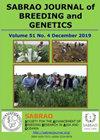印度尼西亚明古鲁省沼泽农业生态系统中沼泽水稻品系的粮食产量稳定性
IF 1.7
Q3 PLANT SCIENCES
引用次数: 0
摘要
2020年的多环境试验项目确认了有前途的沼泽水稻基因型在5种类型的沼泽农业生态系统上的稳定性和适应性。将10个沼泽水稻有利品系和2个对照品种移栽在冲积泥、低地泥炭、低地泥炭、河口中潮和河口下潮沼泽组成的沼泽上,进行产量数据记录,并进行联合方差分析。所采用的AMMI模型阐明了环境对一个基因型的粮食产量稳定性的影响。在测试条件中,冲积泥和低地泥炭沼泽是水稻产量评价最可预测的环境,前者也代表了一个丰富的环境,而后者代表了一个贫穷的环境,尽管它们提供了弱的基因型歧视。低地泥炭沼泽也是一个生产环境,具有强烈的基因型歧视。中下游河口潮沼的结果均较低,且具有合理持久的基因型区分。水稻品系UBPR 1、UBPR 8、UBPR 2和UBPR 4在不同试验环境下的产量和稳定性优于对照品种(图6和图4)。“最佳城市规划大纲3”和“最佳城市规划大纲10”说明了低地泥炭沼泽的理想适应性能。本文章由计算机程序翻译,如有差异,请以英文原文为准。
GRAIN YIELD STABILITY OF SWAMP RICE LINES ACROSS SWAMPLAND AGROECOSYSTEMS IN BENGKULU PROVINCE OF INDONESIA
Multi-environment experiment undertakings in 2020 recognized the stability and adaptability of promising swamp rice genotypes on five types of swampland agroecosystems. Grain yield data recording occurred on 10 swamp rice favorable lines and two check cultivars, transplanted on swamps consisting of alluvial mud, lowland peaty, lowland peat, middle estuarine tidal, and lower estuarine tidal swamp, then subjected to a combined analysis of variance. The AMMI model employed illuminated the effects of environments on a genotype’s grain yield stability across the surroundings. Among the tested conditions, alluvial mud and lowland peat swamps showed as the most predictable environments for rice grain yield evaluation, with the former also representing a rich surrounding, whereas the latter a poor one, despite their provided weak genotype discrimination. Lowland peaty swamp was also a productive environment and conferred strong genotypic discrimination. Both middle and lower estuarine tidal swamps were less fruitful and had rationally durable genotype discrimination. Rice lines UBPR 1, UBPR 8, UPBR 2, and UBPR 4 indicated more desirable than the check cultivars (Inpara 6 and Inpara 4) for grain yield and stability across the test environments. The lines UBPR 3 and UBPR 10 enunciated desirable adaptive performance at the lowland peaty swamp.
求助全文
通过发布文献求助,成功后即可免费获取论文全文。
去求助
来源期刊

Sabrao Journal of Breeding and Genetics
农林科学-奶制品与动物科学
CiteScore
1.90
自引率
50.00%
发文量
63
期刊介绍:
The SABRAO Journal of Breeding and Genetics is an international journal of plant breeding and genetics research and was first published in 1969. It is the official publication of the Society for the Advancement of Breeding Research in Asia and Oceania (SABRAO).
Its objectives are to: promote the international exchange of research information on plant breeding and genetics, by describing new research findings, or ideas of a basic or practical nature; and be a medium for the exchange of ideas and news regarding members of the Society.
The Journal gives priority to articles that are of direct relevance to plant breeders and with emphasis on the Asian region. Invited for publication are research articles, short communications, methods, reviews, commentaries, and opinion articles. Scientific contributions are refereed and edited to international standards.
The journal publishes articles for SABRAO members mainly. The Journal preferred strongly that at least one author should be a current member of the Society. Non-members may also publish in the journal.
 求助内容:
求助内容: 应助结果提醒方式:
应助结果提醒方式:


